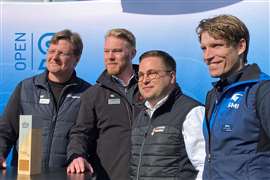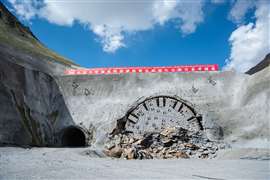Beast on the loose
13 May 2014

The skyline of the harbour of Ghent has long been dominated by the structures that make up the Langerbrugge power station, located alongside the canal that runs from the city to Terneuzen. Construction of the facility began in 1913 for NV stations Electriques des Flandres.
Between 1946 and 1953, the facility was extended to meet the growing demand for electricity from the industries that had established themselves in the area. The station’s capacity was further extended on two separate occasions to meet this increased demand. However, the station eventually ceased operation and was closed down because it had become unprofitable.
For a number of years, the shut-down facility remained a major feature of the cityscape and because of this, the decision-making process to determine what was to happen to it proved a lengthy one. Finally, it was determined that a partial demolition be carried out and the oldest part of the facility, built with bricks and with a distinctive appearance, along with its chimneys be retained as a monument to Ghent’s industrial past.
With various outbuildings on the site cleared, demolition contractor Wanty SA, based in Binche, Belgium, could begin the decommissioning of the main structures on the site, a task that has proven to be a challenging, complex and heavy industrial clearance project that demands the use of a range of techniques. One main challenge is the requirement to carry out the work without causing any damage whatsoever to the structure that is to remain standing on the site.
For example, the decommissioning of the turbines in the old turbine hall has to be manually cut up using oxy-acetylene torches. The sections of metal scrap that result from this operation and then removed from the hall and further processed by a Hitachi ZX870-3 mounting a Genesis GXP 1500R scrap shear and a Hitachi ZX 470-3 also mounting a Genesis scrap shear.
Where the demolition of the tallest structure on the site, a 60 m (197 ft) tall boiler house containing a 4,000 tonne boiler and various other heavy plant. It is on the demolition of this structure that the 88 HRD is being used sporting its 10 tonne Dehaco DSS 950R scrap shear following a period where Wanty searched to find the most appropriate equipment to successfully carry out the work. Its ability to carry a heavy tool to the required height and use it efficiently was the key to its selection for the task. MQP Global brought the machine on site and started the mechanical demolition work at the end of December 2013.
Using this machine offers a number of benefits. First, it reduces the number of man-hours required for the task and the cost of the gases necessary for manual cutting operations. It is also inherently a much safer means of achieving the desired result since there is much less need for workers to be exposed in the area where demolition operations are taking place. Thirdly, and most importantly, its use results in a substantial increase in productivity.
In addition, using mechanical cutting instead of gas techniques reduces the emission of gas and fumes to the environment and a consequent improvement in conditions for the workers, as well as substantially reducing the risk of fire, a major concern during work in chemical and industrial sites.
Engineering the machine
In its first incarnation, MQP Global’ s HRD 88 began life as a modified three stage telescopic high reach version of a Cat 5110 mining shovel with a maximum pin height of 90 m (295 ft), with the design and fabrication carried out by Rusch Special Products in the Netherlands.
Subsequently, the machine was involved with the accident that claimed the life of STC’s Ad Swaninck at that company’s yard when further modification work was being carried out to the Rusch design.
It was handed over to Eureka Engineering based in Ulft, Netherlands, who completely reworked the machine. This involved completely redesigning and fabricating a new undercarriage and chassis on the carrier, as well as redesigning and adjusting the lower stick. The physical fabrication was carried out by Beco Beforce, who has substantial experience in the fabrication of booms and new undercarriage. In addition, a completely new control system was developed by Riwo Engineering BV.
The only elements that remain from the initial Rusch design are the high-tensile steel telescopic boom sections and the single cylinder telescoping mechanism that results in a lighter structure as well as giving the ability to reach to greater heights and/or carry heavier tool weights. However, in its initial incarnation either one or both telescopic sections had to be fully extended when the machine was working. The 88 UHD can now operate with the lower section fully extended and the second extended just to 50% of its full length. This is one reason why the control and telescoping system software had to be reworked to take account of this, since an additional pin in the telescoping section had to be installed.
To assist the operator, an internal light and cameras have been fitted inside the boom sections to allow a clear view of telescoping operations and locking pin engagement.






